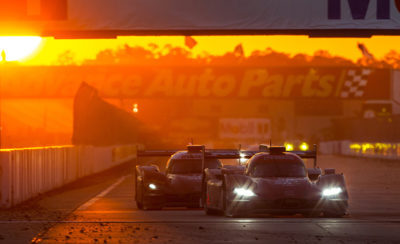Mazda Motorsports’ John Doonan explains the driving force behind Mazda’s participation in racing
“Manufacturers list many reasons why they go racing; for us at Mazda, it’s very specific,” John Doonan, Director of Motorsports at Mazda North American Operations, explained to a group of Mazda employees gathered to take a firsthand look at the Mazda RT24-P Daytona Prototype International car that competes in the IMSA WeatherTech SportsCar Championship, ahead of its appearance at Long Beach. “Some of the reasons on our list may sound a little cliché….Motorsports is the ultimate extreme environment to test automotive components, whether it’s the engine, transmission, suspension components, bodywork or efficiency, the amount of data that can be collected and research that can be done in a three-hour race, a 12-hour race or even a 24-hour race is far more than our engineers perhaps could do on a road car test. We hope that at the very basic levels, our racing activities serve as the laboratory for testing of current products or an outlook for the future.”
Doonan explained that when IMSA came out with its current Daytona Prototype International regulations, it allowed manufacturers to build race cars that suited their company, rather than just stuffing an engine into an existing prototype chassis. Consequently, Mazda set out to incorporate its design language into building the most beautiful race car they could while also making it aerodynamically efficient. Mazda’s designers came up with sketches, then worked with the experts at Multimatic to refine those designs to make them provide the drag and downforce they needed.
“I’m pleased to say we achieved both those goals,” Doonan said. “We’ve been recognized from day one, when we unveiled this car at the LA Auto Show [in 2016] as having the most beautiful expression of the rule set. And as we proved at Sebring, we have a car capable of winning.”
While Mazda didn’t win at Sebring, both cars led and the No. 55 car of Jonathan Bomarito, Harry Tincknell and Spencer Pigot was running second until the final pit stop when an electrical/clutch problem kept the car from immediately restarting.
The RT24-P is the latest in a long line of Mazda race cars and motorsports efforts that date back to the company’s first forays into rotary engines. And from the beginning, it was about testing and proving durability.
“The first time we put our rotary engine into a production car, our engineers felt the best place to test reliability and durability of our unique little engine was to take it to a race. They didn’t just take it to any race, they took it to an 84-hour race. Eighty-Four hours – not broken up into 10 workdays of eight hours, but 84 hours at the Nürburgring. At the end of 84 hours, the cars finished, and our top-finishing car finished in fourth place. Durability and reliability is absolutely a foundation for most manufacturers, and for Mazda from day one, it’s why we go racing,” Doonan said.
It’s not just the pros testing Mazda products on the track, but 20,000 racers putting stress on Mazda cars and engines in amateur and entry-level pro racing around the country. From Spec Miata to Touring to Super Touring to Mazda engines powering Formula Atlantics and prototypes, Mazda has roughly half the share of the club racing market – and that doesn’t even count the thousands of Mazda drivers competing in autocross, RallyCross and other forms of competition. Mazda competing at the highest levels of motorsport trickles down to them in the form of better components and more reliable parts. But it also serves as something aspirational.
“The Prototype program is our pinnacle program,” explained Doonan. “From a driver development standpoint, if there are drivers that are in our grassroots program and they have aspirations of having a career at the highest levels of the sport, this is the aspirational goal. From a brand perspective, obviously we tell our design story, and it is our hope we’re telling an efficiency story with the smallest displacement in the field. And I think owner loyalty…it is our hope that when our most loyal fans – racers who have invested so much in racing a Mazda – see us have success, it’s a reinforcement of their decision to race a Mazda.”
Aside from the RT24-P, Mazda’s other professional racing programs in the U.S. include the Mazda Road to Indy, where all of the cars in the Indy Lights Presented by Cooper Tires, Pro Mazda Championship and Cooper Tires USF2000 Championship Powered by Mazda have Mazda engines; the IMSA Prototype Challenge Presented by Mazda, where Mazda’s MZR engine powers the Mazda Prototype Challenge category; the Idemitsu Mazda MX-5 Cup presented by BFGoodrich® Tires; and Pirelli World Challenge, where the MX-5 Cup car competes in Touring Car A. Scholarships to move into many of these series, or up the ladder, are provided to races in the form of advancement scholarships to championship winners, the Mazda Road to Indy Shootout and the Mazda Road to 24 Shootout.
New for 2018 is the Spec Miata $30K Challenge, where the Spec Miata driver with the most points across eight SCCA Hoosier Super Tour races will earn $30,000 paid to an MX-5 Cup team to compete in two Idemitsu Mazda MX-5 Cup weekends.


 ACCESSIBILITY
ACCESSIBILITY